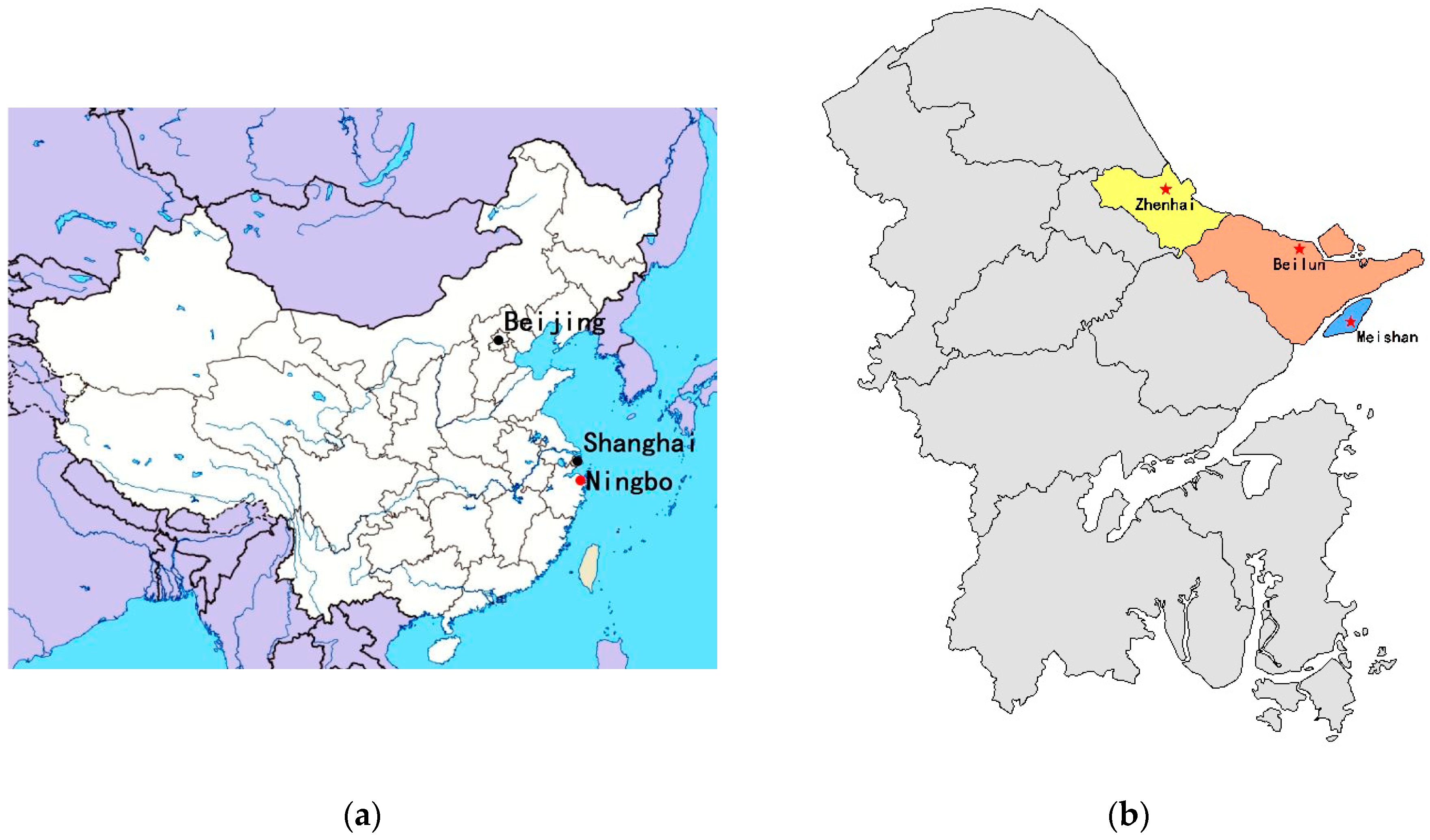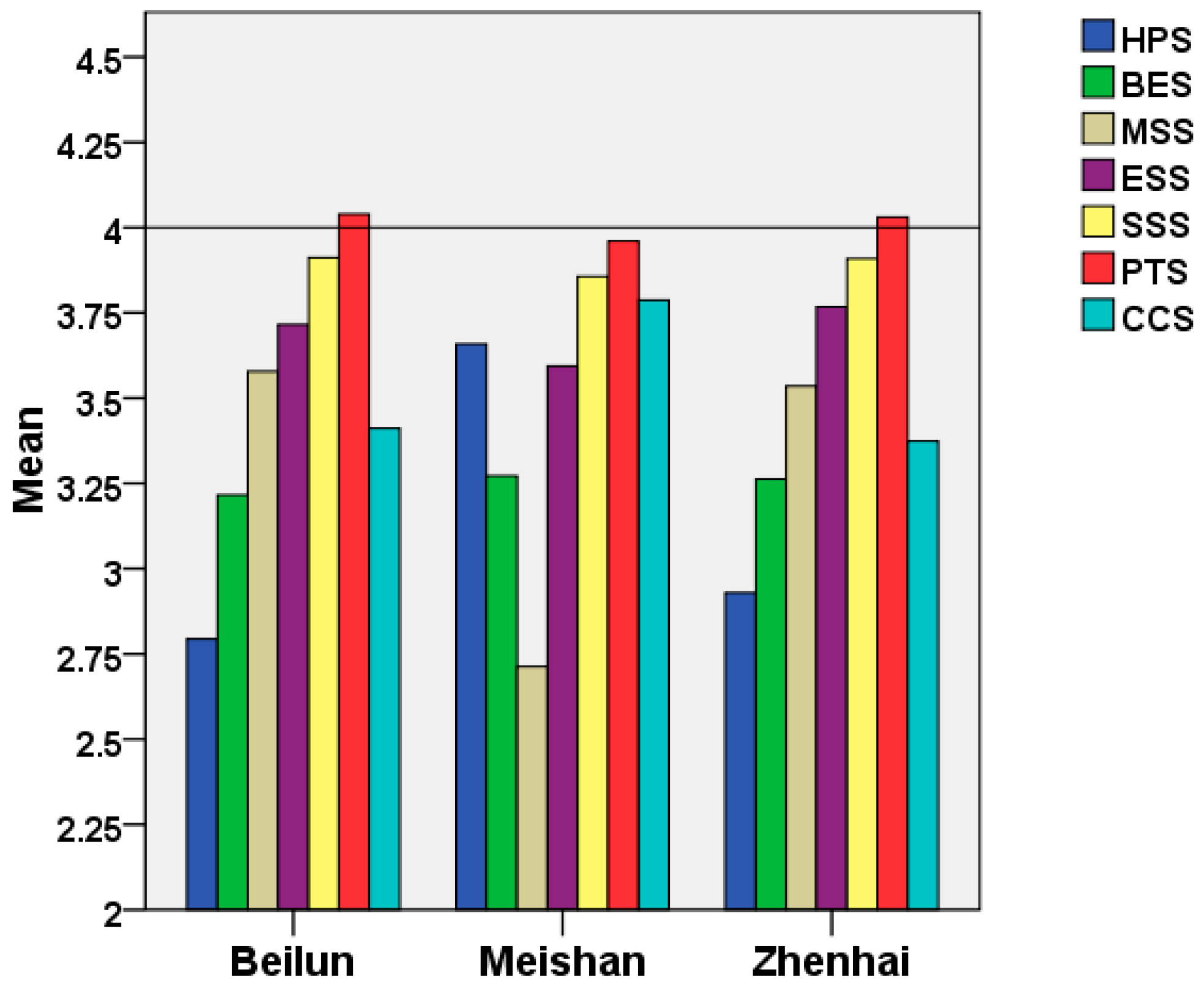Impact of Building Environment on Residential Satisfaction: A Case Study of Ningbo
Abstract
1. Introduction
2. Literature Review
3. Survey
3.1. Study Area
3.2. Sampling Technique and Investigated Port Communities
3.3. Questionnaire Design and Survey Conduction
4. Data Analysis
4.1. Demographic and Socioeconomic Features of Respondents
4.2. Housing and Neighbourhood Attributes
4.3. Residential Satisfaction and Other Kinds of Satisfaction
5. Influence Factors of Residential Satisfaction
5.1. Socioeconomic Factors of Respondents
5.2. Factors of Building Environment
6. Conclusions
Author Contributions
Funding
Acknowledgments
Conflicts of Interest
References
- Burton, E. Measuring urban compactness in UK towns and cities. Environ. Plan. B Plan. Des. 2002, 29, 219–250. [Google Scholar] [CrossRef]
- Yao, Y.L. Energy Consumption and Space Density in Urban Area. Energy Procedia 2011, 5, 895–899. [Google Scholar]
- Yin, Y.; Mizokami, S.; Aikawa, K. Compact development and energy consumption: Scenario analysis of urban structures based on behavior simulation. Appl. Energy 2015, 159, 449–457. [Google Scholar] [CrossRef]
- Huang, Q.; Xu, J.; Qin, H.; Gao, X. Understanding Land Use and Rural Development in the National Scheme of Village Relocation and Urbanization in China: A Case Study of Two Villages in Jiangsu Province. Sustainability 2018, 10, 3227. [Google Scholar] [CrossRef]
- Overview of Ningbo, Ningbo Government Official Website. Available online: http://english.ningbo.gov.cn/col/col934/index.html (accessed on 14 June 2018).
- Prosperous Future of Ningbo-Zhoushan Port, Ningbo Government. Available online: http://english.ningbo.gov.cn/art/2017/9/1/art_952_835933.html (accessed on 1 September 2017).
- Marziyeh, R.; Emami, A. Residential satisfaction in affordable housing: A mixed method study. Cities 2018, 82, 1–9. [Google Scholar]
- Gaigné, C.; Stéphane, R.; Thisse, J.F. Are compact cities environmentally friendly? J. Urban Econ. 2012, 72, 123–136. [Google Scholar] [CrossRef]
- Yin, Y.; Mizokami, S.; Maruyama, T. An analysis of the influence of urban form on energy consumption by individual consumption behaviors from a microeconomic viewpoint. Energy Policy 2013, 61, 909–919. [Google Scholar] [CrossRef]
- Lee, S.; Lee, B. The influence of urban form on GHG emissions in the U.S. household sector. Energy Policy 2014, 68, 534–549. [Google Scholar] [CrossRef]
- VonThunen, J.H. Der isolierte Staat in beziehung auf Land wirtschaft und Nationalokonomie, Gustav Fisher, Stuttgart; Hall, P., Ed.; Wartenburg, C.M., Translator; English Edition: The Isolated State; Pergamon: Oxford, UK, 1826. [Google Scholar]
- Alonso, W. Location and Land Use; Harvard University Press: Cambridge, MA, USA, 1964. [Google Scholar]
- Zhou, B.; Kockelman, K. Microsimulation of residential land development and household location choices: Bidding for land in austin, texas. Transp. Res. Rec. 2008, 2017, 106–112. [Google Scholar] [CrossRef]
- Pinjari, A.R.; Bhat, C.R.; Hensher, D.A. Residential self-selection effects in an activity time-use behavior model. Transp. Res. Part B Methodol. 2009, 43, 729–748. [Google Scholar] [CrossRef]
- Yin, Y.; Aikawa, K.; Mizokami, S. Effect of housing relocation subsidy policy on energy consumption: A simulation case study. Appl. Energy 2016, 168, 291–302. [Google Scholar] [CrossRef]
- Cao, X. Is alternative development undersupplied? Examination of residential preferences and choices of Northern California movers. Transp. Res. Rec. J. Transp. Res. Board 2008, 2077, 97–105. [Google Scholar] [CrossRef]
- Lewis, P.G.; Baldassare, M. The complexity of public attitudes toward compact development. J. Am. Plan. Assoc. 2010, 76, 219–237. [Google Scholar] [CrossRef]
- Elizabeth, C.; Zhou, D.Y.; Thill, J.C. Densification without Growth Management? Evidence from Local Land Development and Housing Trends in Charlotte, North Carolina, USA. Sustainability 2014, 6, 3975–3990. [Google Scholar]
- Howley, P. Attitudes towards compact city living: Towards a greater understanding of residential behavior. Land Use Policy 2009, 26, 792–798. [Google Scholar] [CrossRef]
- Wu, W.J.; Zhang, W.Z.; Dong, G. Determinant of residential location choice in a transitional housing market: Evidence based on micro survey from Beijing. Habitat Int. 2013, 39, 16–24. [Google Scholar] [CrossRef]
- Tian, G.; Ewing, R.; Greene, W. Desire for Smart Growth: A Survey of Residential Preferences in the Salt Lake Region of Utah. Hous. Policy Debate 2014, 25, 446–462. [Google Scholar] [CrossRef]
- Liao, F.H.; Farber, S.; Ewing, R. Compact development and preference heterogeneity in residential location choice behaviour: A latent class analysis. Urban Stud. 2015, 52, 314–337. [Google Scholar] [CrossRef]
- He, S.; Qi, X. Determinants of relocation satisfaction and relocation intention in chinese cities: An empirical investigation on three types of residential neighborhood in Guangzhou. Sci. Geogr. Sin. 2014, 34, 1327–1336. [Google Scholar]
- Rose, J.M.; Bliemer, M.C.J. Constructing efficient stated choice experimental designs. Transp. Rev. 2009, 29, 587–617. [Google Scholar] [CrossRef]
- Li, Z.; Wu, F. Residential satisfaction in China’s informal settlements: A case study of beijing, Shanghai, and Guangzhou. Urban Geogr. 2013, 34, 923–949. [Google Scholar] [CrossRef]
- Rossi, P.H. Why Families Move: A Study in the Social Psychology of Urban Residential Mobility; Free Press: New York, NY, USA, 1955. [Google Scholar]
- Lovejoy, K.; Handy, S.; Mokhtarian, P. Neighborhood satisfaction in suburban versus traditional environments: An evaluation of contributing characteristics in eight California neighborhoods. Landsc. Urban Plan. 2010, 97, 37–48. [Google Scholar] [CrossRef]
- Chen, L.; Zhang, W.; Yang, Y.; Yu, J. Disparities in residential environment and satisfaction among urban residents in Dalian, China. Habitat Int. 2013, 40, 100–108. [Google Scholar] [CrossRef]
- Mohit, M.A.; Ibrahim, M.; Rashid, Y.R. Assessment of residential satisfaction in newly designed public low-cost housing in Kuala Lumpur, Malaysia. Habitat Int. 2010, 34, 18–27. [Google Scholar] [CrossRef]
- Lin, S.; Li, Z. Residential satisfaction of migrants in Wenzhou, an ‘ordinary city’ of China. Habitat Int. 2017, 66, 76–85. [Google Scholar] [CrossRef]
- Parkes, A.; Kearns, A.; Atkinson, R. What makes people dissatisfied with their neighbourhoods? Urban Stud. 2002, 39, 2413–2438. [Google Scholar] [CrossRef]


| Variable | Attribute | Percentage (%) | Mean | Std. Dev. |
|---|---|---|---|---|
| Gender | Male | 52.6 | 1.47 | 0.5 |
| Female | 47.4 | |||
| Age | 20–30 years | 8.9 | 2 | 0.747 |
| 30–45 years | 59.3 | |||
| 45–60 years | 23.6 | |||
| >60 years | 8.2 | |||
| Education | High school or less | 31.5 | 2 | 0.556 |
| College and Bachelor | 63.8 | |||
| Master and Doctor | 4.7 | |||
| Occupation | Workers in private companies | 35.5 | 2.46 | 1.327 |
| Employee in state-owned companies, government and public institutions | 23.3 | |||
| College students | 1.2 | |||
| Self-employed | 40 | |||
| Household income | <50,000 yuan/year | 18.1 | 2.52 | 1.054 |
| 50,000–100,000 yuan/year | 31.8 | |||
| 100,000–240,000 yuan/year | 35.2 | |||
| 240,000–420,000 yuan/year | 9.9 | |||
| >420,000 yuan/year | 5 | |||
| Family size | Single | 3.2 | 3.07 | 0.735 |
| Married without child | 13.2 | |||
| Married with one child | 56.6 | |||
| Married with two children | 27 |
| Attribute | Variable | Harbour Area | Minimum | Maximum | Mean | Std. Dev. |
|---|---|---|---|---|---|---|
| Housing attribute | Ownership (own = 1, rent = 2) | Beilun | 1 (93.1%) | 2 (0.79%) | 1.07 | 0.254 |
| Zhenhai | 1 (75.8%) | 2 (25.2%) | 1.24 | 0.431 | ||
| Meishan | 1 (93.1%) | 2 (6.9%) | 1.07 | 0.255 | ||
| Building year of house | Beilun | 2009 | 2002 | 2005 | 2.6 | |
| Zhenhai | 1990 | 2010 | 1995 | 6.147 | ||
| Meishan | 2012 | 2015 | 2012 | 1.405 | ||
| Floor area (1: <60 m2; 2: 60–90 m2; 3: 90–130 m2; 4: >130 m2) | Beilun | 1 (5.9%) | 4 (37.3%) | 3.17 | 0.822 | |
| Zhenhai | 1 (40.4%) | 4 (2.0%) | 1.76 | 0.744 | ||
| Meishan | 1 (0.5%) | 4 (17.8%) | 2.94 | 0.651 | ||
| Price (yuan/m2) | Beilun | 14,424 | 26,665 | 19,413 | 4818 | |
| Zhenhai | 11,034 | 14,792 | 12,783 | 1330 | ||
| Meishan | 8948 | 13,474 | 11,441 | 1906 | ||
| Community attribute | Community type (CF = 1, CFH = 2, RH = 3, SBH = 4) | Beilun | 1 (49%) | 4 (21.6%) | 2.24 | 1.268 |
| Zhenhai | 1 (43.4%) | 3 (26.3%) | 1.83 | 0.821 | ||
| Meishan | 1 (65.3%) | 3 (34.7%) | 1.35 | 0.477 | ||
| Population density (person/km2) | Beilun | 17,572 | 22,000 | 19,330 | 1769 | |
| Zhenhai | 15,994 | 19,400 | 18,210 | 1340 | ||
| Meishan | 9098 | 15,558 | 12,194 | 2619 | ||
| Floor area ratio | Beilun | 1.4 | 2.3 | 1.95 | 0.366 | |
| Zhenhai | Null | Null | Null | Null | ||
| Meishan | 0.7 | 1.5 | 1.13 | 0.332 | ||
| Distance to district commercial centre (km) | Beilun | 0.2 | 2.7 | 1.43 | 1.009 | |
| Zhenhai | 0.5 | 1.6 | 1.18 | 0.43 | ||
| Meishan | 2.5 | 11.5 | 5.87 | 4.11 | ||
| Distance to harbour working zone (km) | Beilun | 2.7 | 6.1 | 4.8 | 1.187 | |
| Zhenhai | 1 | 3 | 2.14 | 0.933 | ||
| Meishan | 2.8 | 9.5 | 6.88 | 3 |
| Variables | Standardised Coefficients | Std. Error | t | Sig. | VIF |
|---|---|---|---|---|---|
| Gender | 0.102 | 0.077 | 2.114 | 0.035* | 1.035 |
| Age | 0.092 | 0.056 | 1.748 | 0.081 | 1.221 |
| Education | 0.086 | 0.080 | 1.531 | 0.127 | 1.393 |
| Occupation | 0.066 | 0.029 | 1.352 | 0.177 | 1.073 |
| Household income | 0.266 | 0.039 | 5.132 | 0.000** | 1.200 |
| Family size | −0.046 | 0.054 | −0.933 | 0.351 | 1.097 |
| Standardised Coefficients | Std. Error | t | Sig. | VIF | |
|---|---|---|---|---|---|
| Housing price | 0.072 | 0.000 | 1.303 | 0.193 | 2.542 |
| Ownership of the house | 0.063 | 0.112 | 1.624 | 0.105 | 1.253 |
| Floor area | 0.035 | 0.051 | 0.681 | 0.496 | 2.178 |
| New level of building | 0.108 | 0.045 | 2.226 | 0.027* | 1.977 |
| Design of building | 0.292 | 0.049 | 6.211 | 0.000** | 1.859 |
| Type of community | −0.221 | 0.041 | −5.462 | 0.000** | 1.381 |
| Population density | −0.275 | 0.000 | −4.293 | 0.000** | 3.449 |
| Distance to district commercial centre | −0.484 | 0.019 | −6.311 | 0.000** | 4.957 |
| Distance to port working zone | −0.072 | 0.018 | −1.253 | 0.211 | 2.769 |
© 2019 by the authors. Licensee MDPI, Basel, Switzerland. This article is an open access article distributed under the terms and conditions of the Creative Commons Attribution (CC BY) license (http://creativecommons.org/licenses/by/4.0/).
Share and Cite
Yin, Y.; He, Y.; Zhang, L.; Zhao, D. Impact of Building Environment on Residential Satisfaction: A Case Study of Ningbo. Sustainability 2019, 11, 1197. https://doi.org/10.3390/su11041197
Yin Y, He Y, Zhang L, Zhao D. Impact of Building Environment on Residential Satisfaction: A Case Study of Ningbo. Sustainability. 2019; 11(4):1197. https://doi.org/10.3390/su11041197
Chicago/Turabian StyleYin, Yanhong, Yuanwen He, Lei Zhang, and Dan Zhao. 2019. "Impact of Building Environment on Residential Satisfaction: A Case Study of Ningbo" Sustainability 11, no. 4: 1197. https://doi.org/10.3390/su11041197
APA StyleYin, Y., He, Y., Zhang, L., & Zhao, D. (2019). Impact of Building Environment on Residential Satisfaction: A Case Study of Ningbo. Sustainability, 11(4), 1197. https://doi.org/10.3390/su11041197




